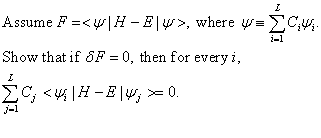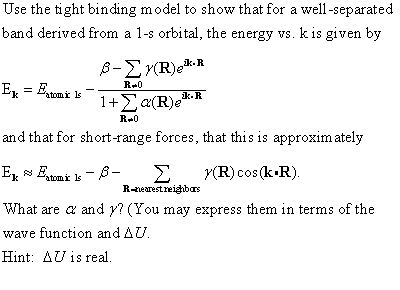Homework
Solid State Physics
| # | Date due | Assignment |
| 1 | 9/1 | Marder, Chapter 1: Problems 3, 4, 5(a). Also, for each of the five Bravais lattices, identify all rotations and mirror lines that leave the lattice invariant. Also specify whether the lattice has inversion symmetry. Solutions: main solutions, problem 1.5a. |
| 2 | 9/7 | Marder, Chapter 2, Problems 1, 6, 7. Chapter 3, problem 1. Additional problem: The melting points of most solids increase as applied pressure increases. Water is a notable exception. July Physics Today reports a new experiment that shows that sodium also melts at lower temperatures at high pressure. Refer to our discussoin of Gibbs Free Energy. What unusual property might sodium share with water that explains this unusual result? |
| 3 | 9/14 | 1. Marder, Chapter 3, problem 2. 2. Let (ijk) be a plane that intersects the lattice at points a1/, a2/j, and a3 /k. Show that the reciprocal lattice vector given by ib1 + jb2 + kb3 is perpendicular to this plane. The (i j k) notation for planes is standard. 3. Prove that the distance between adjacent parallel planes in the real lattice as desribed above is proportional to the magnitude of the corresponding recprocal lattice vector, and determine the constant of proportionality. 4. Determine the volume of a primitive unit cell in a hexagonal lattice. 5. Prove that the volume of the first Brillouin zone is inversely proportional to the volume of the primitive unit cell in the space lattice. 6. a. Assuming the gibbs free energy of formation of a Frenkel defect in CaF2 is 2.5 eV, determine the equilibrium concentration of fluoride interstitials at 300K. b. At what temperature would the equilibrium concentration of defects double? c. The enthalpy of activation for motion of the fluoride interstitial is approximately 1.1 eV. Assume that the entropy of activation is about 1k, where k is Boltzman's constant. The vibrational frequency of interstitials is roughly 1013 Hz. Grossly estimate the time to reach equilibrium at temperatures of 250K, 300K, and 350K. |
| 4 | 9/21 | Marder, Ch. 4, problems 3, 4. Ch. 5, problem 1, 2. Install the software described in the e-mail you received, become familiar with it, and design te crystal models specifiied. Pick one structure, and add two more unit cells. |
| 5 | 10/5 | Marder, Ch. 5: problems 5, 7. Chapter 6: problems 1, 2, 3, 4. |
| 6 | 10/12 | Marder, Ch. 6: Problem 8. Ch. 7, problems 2, 3. |
| 7 | 11/2 | Consider a square wave potential with lattice constant a. In the first unit cell, this means:
This is repeated throughout the crystal.
|
| 8 | 11/9 | 1.
2.
|

